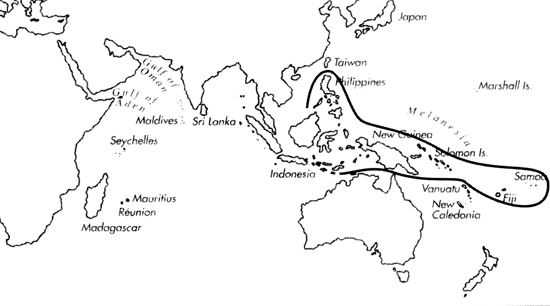
Skip Navigation Links
View access keys for this site.

Range: Philippines, Papua New Guinea, Solomon Is., Samoa, and Fiji; also recorded from E. Indonesia.
Description: Moderately large to large, solid to moderately heavy. Last whorl narrowly conoid-cylindrical to narrowly conical; outline convex near shoulder, straight below. Depth of exhalent notch about 1/3 of maximum diameter. Shoulder subangulate to rounded. Spire usually of moderate height, stepped; outline slightly concave to slightly convex. Larval shell of about 3.5 whorls, maximum diameter about 1 mm. First 5-6 postnuclear whorls tuberculate. Teleoconch sutural ramps concave, with 1 increasing to 5-10 fine spiral grooves; sculpture very weak in latest whorls. Last whorl with weak spiral ribs basally and distinct spiral striae above.
| Shell Morphometry | ||
|---|---|---|
| L | 75-162 mm | |
| RW | 0.35-0.83 g/mm | |
| (L 75-147 mm) | ||
| RD | 0.45-0.50 | |
| PMD | 0.79-0.86 | |
| RSH | 0.18-0.24 | |
Ground colour white; edges of late postnuclear whorls may be tinged with blue and last whorl may have blue axial streaks; blue shading most prominent in shells from Solomon Islands (Pl. 68, Fig. 15). Last whorl with a network of fine orangish brown to brown lines producing tiny to small tents and with usually 3 spiral rows or bands of yellowish brown blotches, below shoulder, just above centre, and within basal third. Brown zones with broad dark brown axial lines and dotted to solid spiral lines variably articulated with white dots and tents. Larval whorls orange to pink. First 3-4.5 postnuclear sutural ramps pink, immaculate in first 0.5-3 whorls and with brown marginal dots in remaining whorls. Following sutural ramps matching last whorl in colour pattern. Aperture white.
Periostracum yellowish to brownish grey, thin, translucent, smooth.
Dorsum of foot white mottled with brown, with a dotted dark brown pre-marginal line; anterior part broadly edged with orange and with a central black spot; latero-posterior zones densely marked with brown. Sole of foot mottled brown and beige. Rostrum white, or brown with dark brown transverse stripes and grading to immaculate white distally. Tentacles matching rostrum in colouration; tip with a dark brown outer side. Siphon cream with transverse brown mottling, grading to immaculate red distally and with a broad black ring centrally (Wilson & Gillett, 1971; Chaberman, pers. comm., 1981; Richards, pers. comm., 1989).
Habitat and Habits: In 10-300 m, on sand and mud bottoms. C. gloriamaris is known to prey on molluscs.
Discussion: C. gloriamaris resembles C. textile and C. bengalensis. C. textile differs in its broader last whorl (RD 0.50-0.72) with a less straight outline and in its lower spire (RSH 0.11-0.20); its aperture is relatively wider at base and its exhalent notch not so deep. For comparison with C. bengalensis see the Discussion of that species. A specimen from Cuyo Is., Philippines (Pl. 68, Fig. 17) corresponds closely with C. gloriamaris in its conchological characters except for a broader last whorl (RD ca. 0.55) and a slightly lower spire (RSH 0.17). We provisionally assign it to C. gloriamaris.

C. gloriamaris range map
This section contains verbatim reproductions of the accounts of 316 species of Conus from the Indo-Pacific region, from Manual of the Living Conidae, by Röckel, Korn and Kohn (1995). They are reproduced with the kind permission of the present publisher, Conchbooks.
All plates and figures referred to in the text are also in Röckel, Korn & Kohn, 1995. Manual of the Living Conidae Vol. 1: Indo-Pacific Region.
The range maps have been modified so that each species account has it own map, rather than one map that showed the ranges of several species in the original work. This was necessary because each species account is on a separate page on the website and not confined to the order of accounts in the book.
Return to framed version (returns to search page)